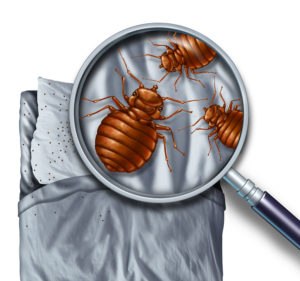 COMMON NAME: Bed Bug
COMMON NAME: Bed Bug
SCIENTIFIC NAME: Cimex lectularius Linnaeus CLASS/ORDER/FAMILY: Insecta/Heteroptera/Cimicidae
INTRODUCTION. This bug probably received its common name of bed bug from its close association with human sleeping beds where it often seeks refuge during daylight, only to come out to feed on the bed’s occupant(s) at night. The bed bug is an ecto-parasite of primarily humans but will also attack poultry and other mammals and birds. It was introduced into the United States with the early colonists. It is found throughout the United States and the world.
RECOGNITION. Adults about 3/16″ (4-5 mm) long; broadly oval and flat. Color brown to reddish brown (after feeding). Head with beak/proboscis 3-segmented, not extending beyond front coxae. Ocelli absent. Antenna 4-segmented, 3rd segment longer than 2nd or 4th.
BIOLOGY. Female bed bugs lay 1-5 eggs per day with the 1/32″ (1 mm) long, white eggs being deposited individually in cracks or on rough surfaces and secured with a transparent cement for an average total of 200 eggs; maximum eggs per day is 12, with 541 for a lifetime. With normal feeding and reproductive cycles, individuals can live up to 316 days. Humans are the preferred host of bed bugs but in their absence bed bugs will feed on poultry, canaries, English sparrows, mice, rats, guinea pigs, and bats. Although the bite of bed bugs is painless, most people (80%) develop an allergic reaction to the saliva injected by the bug as it feeds. A swelling usually results from feeding but there is no red spot such as is characteristic with flea bites. Swelling may be severe and extend beyond the immediate bite area in highly sensitive individuals. Bed bugs have been found to be infected with some 25 different disease organisms.
HABITS. Bed bugs harbor in cracks and crevices during the day and come out to feed at night. Typically they can be found around mattress buttons and beading, in box springs or their coverings, and in any crevice of a wooden bed frame, such as where members join. Other places to check are wall hangings such as picture frames, night stands, stuffed furniture, baseboards, floorboard cracks, behind loose wallpaper, light switches, door and window frames, conduits, etc. In heavy infestations, bed bugs may be found in wall voids, attics, and other enclosed places. They will crawl considerable distances to obtain a blood meal. They can be introduced into a structure via used furniture or in the belongings of someone who has been living in a bed bug infested situation. Adults can survive for up to 6-7 months if they are well fed and they can feed on other animals if humans are not present. When the temperature falls below 61°F/16°C, adults enter semi-hibernation and can survive for months. Bed bug infestations have been found in transportation vehicles such as boats, trains, airplanes, and buses as well as in movie theaters where they typically harborage in seats and associated frames. Besides the characteristic obnoxiously sweet odor, the other primary clues to an infestation will be the presence of bed bugs and/or small red to reddish brown fecal spots here and there on surfaces.
CONTROL. A thorough inspection is indispensable. Treat any bed bugs found with an appropriately labeled pesticide. Great care should be taken when treating mattresses, box springs, and upholstery to keep pesticide exposure to the customer to a minimum; allow for thorough drying before reuse. Infant’s and infirmed person’s bedding and bed frames should not be treated. They should be replaced with un-infested items. In homes, most bed bugs infestations can be controlled with a single application to mattresses, bed frames, wall crevices, and baseboards. In apartment buildings and hotels, it’s advisable to also inspect units to either side and above and below the infested unit, and treat as required.
